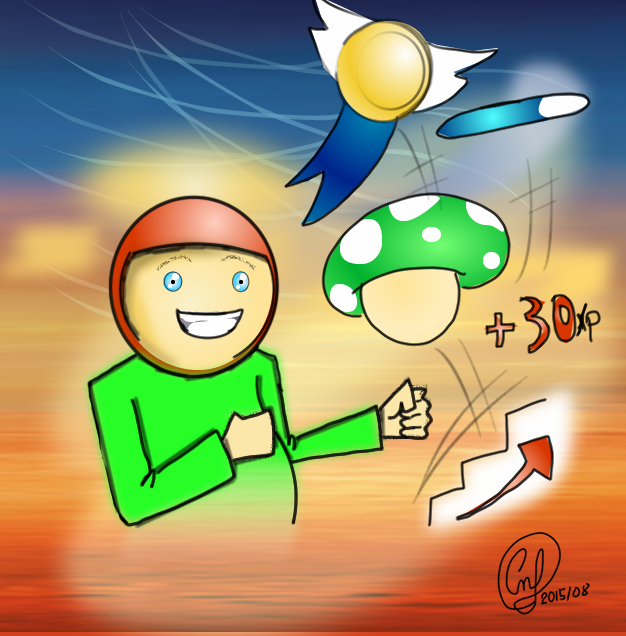
Gamification will fail, says Gartner. ![]() This is an often-quoted reference about gamification, and it brings, of course, doubts about if gamification should or should not be implemented.
This is an often-quoted reference about gamification, and it brings, of course, doubts about if gamification should or should not be implemented.
Gamification is the use of elements commonly belonging to games with a purpose that goes beyond pure entertainment. In the case of my study it was about the use of game elements in a business context, in order to make people more motivated and engaged to perform in their works while reaching the business’ goals.
With such an uncertain effectiveness of gamification in mind, I developed with Scania IT (Södertälje, Sweden) a framework to measure people’s (employees) anticipation of [Enterprise] Gamification. This framework takes into account the lean principle of elimination of waste focused in a service company. The idea with this framework is to determine whether people view the gamification of the activites with optimism or with apathy, giving therefore a clue to the company if it is worthed to invest on it or not.
The framework intends to measure how optimistic (or indifferent) people are regarding the implementation of Gamification and it is based on two other gamification frameworks for effective gamification:
- the kaleidoscope of effective gamification, by Kappen and Nacke (2013) and
- the method of analysis and application of gamification, by Aparicio et al. (2012).
The combination of those two frameworks added to the Self Determination Theory proposed by Ryan and Deci (2000) to measure people’s psychological satisfaction (sense of autonomy, competence, and relatedness), allowed me to define the steps below to determine people’s anticipation to gamification. The steps are connected to an enterprise setting but they could be generalized to any other context: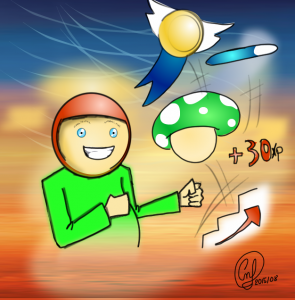
- Check what is the main objective to be gamified. The main objective should be able to clearly add value to the customer of the product or service.
- Identify transversal objectives, which are the goals that can be connected to the main objective and are simultaneously important to those playing the gamified solution. In my case I used a survey to make this elicitation.
- Measure current goals’ fulfillment. As several literatures on gamification highlight, the goals in a gamified system should be very clear, reachable and measureable; that is the only way you can really say that gamification was effective on reaching the goals (and therefore the defined objectives).
- Measure current psychological satisfaction. Just as in a game you develop the competence as you move on to the next levels, you should have autonomy of choices and have other persons to relate to which are playing the same game, gamification should improve those three psychological needs (autonomy, competence, and relatedness). I used a survey to measure the self-efficacy of people regarding their autonomy, competence and relatedness. After an actual implementation of a gamified solution that is the way to see if people felt motivated to engage in the game (on a psychological dimension rather than the pure corporative dimension defined in step 3).
- List gamification elements that could be implemented and check with the players (or users of the gamified solution) if they look towards each element favorably or not. I used a survey to get people’s opinions.
Steps 1 and 2 (definition of main and transversal objectives) allow us to create a tree like the one below to connect both main and transversal goals. It gives direction to the person (or team) who is going to gamify a given context about what goals a player should pursue when in the game. The picture below contains a sample of how transversal objectives could lead to the main objectives.
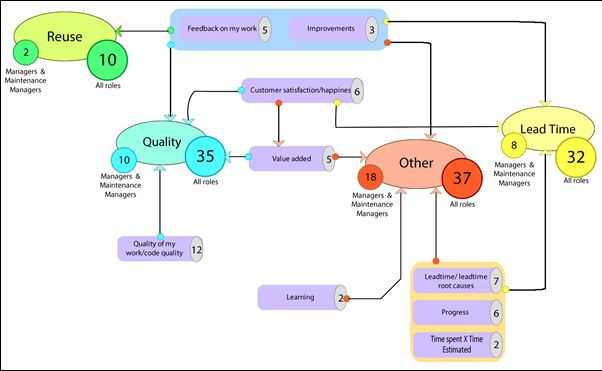
An explanation of the tree above follows:
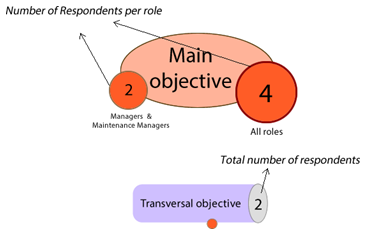
Steps 3 and 4 are needed because gamification needs to tackle two dimentions: 1) reaching the business goals and 2) satisfying emotional/psychological needs. The figure below exemplifies in which scenario gamification can be considered effective.

Steps 4 and 5 alllow us to define if people view gamification with optimism (green zone in the figure below) or indifference (red zone, including the line).One chart like the one below is generated for each psychological need to be satisfied with game elements.
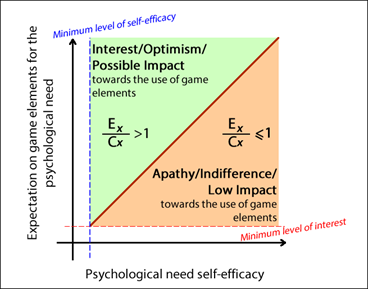
Below you can see how this chart could be filled in with every subject of a survey, for each of the three psychological needs:
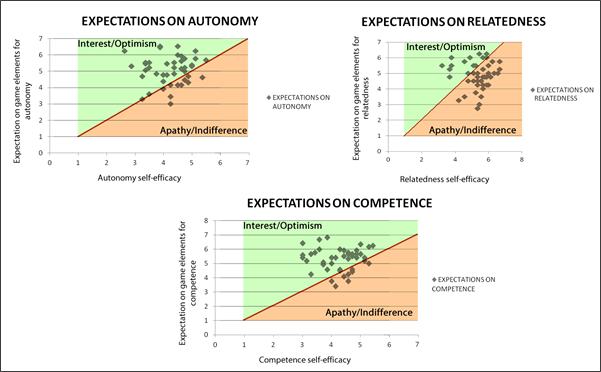
This is a summary of my thesis, if you want to read the complete version, please go to: http://bit.ly/Thesis-GamificationAnticipationV1
Gamification anticipation value
- Each game element should be able to improve one’s psychological need. As an example “immediate feedback” is supposed to give to a person autonomy (because the person can see by herself the impact of her actions) and competence (because the person knows that performed action brings a certain outcome and improving the performance would improve the outcome).
- To define the Motivated Behavior layer (Kappen & Nacke 2013) and select game mechanics (Aparicio et al. 2012), i.e. see which game elements are more likely to cause an impact on people’s motivation to pursue whichever objective is defined, the following steps are proposed:
- Measure the current self-perception of autonomy, competence, and relatedness (hereinafter CA, CP, and CR, respectively, and Cx generically). The expected value [of interest/optimism] towards gamification elements tackling autonomy, competence, and relatedness (EA, EP, and ER respectively, and Ex generically) in a scale 1 to 7 will also be collected.
- Ex will then be compared to Cx. I expect that if Ex is higher than Cx then there is a chance to the expected gamification element to cause an impact on improving the psychological need in question. However, if Ex is equal or lower than Cx, there is a possibility of indifference towards the game elements to be implemented (or low impact on the implementation). Therefore the ratio should be higher than 1 to indicate the possibility of effectiveness of the implementation of the set of game elements connected to the specific psychological need. See the Gamification Anticipation chart above expressing this assumption graphically.
- Cx is defined by the average of all the answers to the questions in the survey related to business practices and goals, which are connected to the psychological need X in question (autonomy, competence, relatedness).
- Ex is defined by the average of all the answers to the questions in the survey regarding game elements connected to the psychological need X in question (autonomy, competence, relatedness).
What does the anticipation mean?
This is something I intend to explore now. Every psychological need (autonomy, competence, and relatedness) was self-assessed by the respondents in a scale from 1 to 7 (defining Cx). The same thing with the expectation (Ex) towards game elements to improve a given psychological need. The relation between the expectation Ex and the self-efficacy Cx gives the degree of optimism. Using a scale from 1 to 7, the possible outcomes are given in the picture below:
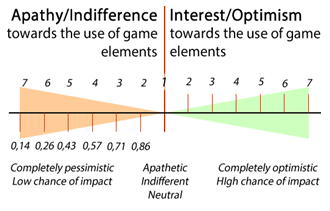
The picture above is nothing but an ortogonal line to the apathy line in which you will then project the points in the Gamification Anticipation Chart shown previously. The anticipation value (Ex / Cx) can assume (using a range from 1 to 7 in the survey) values going from 0,14 to 7 (respectively, completely pessimistic – low chance of impact of gamification to completely optimistic – high chance of impact of gamification). If the case is one of complete apathy, it means that people in the context under study have a high self-efficacy. On the other hand, too much optimism mean that people have a really low self-efficacy when it comes to the satisfaction of their psychological needs and rely too much in external factors (i.e. gamification elements in this case) to improve them.
Next steps
I intend to verify now how the gamification anticipation relates to the actual implementation of a solution. Do people feel that their psychological needs increased as they expected? To do this an implementation is required. And implementation is the next step!
Acknowledgements
Several people helped me in creating this experiment, I want to thank them all (and most of them are individually mentioned in my thesis). Of course Scania IT played a big role on the development of this framework, and I want to thank Åke Zetterberg for the availability, oportunity and openness. I also thank the CAPES Foundation from Brazil for the financing.
My gratitude to all 82 volunteers who answered the surveys and contributed to this study.
References
Aparicio, A.F. et al., 2012. Analysis and application of gamification. Proceedings of the 13th International Conference on Interacción Persona-Ordenador – INTERACCION ’12, pp.1–2. Available at: http://dl.acm.org/citation.cfm?doid=2379636.2379653.
Freitas, C.N. , 2015. Lean-based Enterprise Gamification. University of Skövde. Available at: https://www.researchgate.net/publication/282196184_Lean-based_enterprise_gamification
Kappen, D.L. & Nacke, L.E., 2013. The kaleidoscope of effective gamification: deconstructing gamification in business applications. Proceedings of the First International Conference on Gameful Design, Research, and Applications – Gamification ’13, pp.119–122. Available at: http://dl.acm.org/citation.cfm?doid=2583008.2583029.
Rimon, G., 2013. How to Measure the ROI of Gamification | Gamification Co. Available at: http://www.gamification.co/2013/07/17/how-to-measure-the-roi-of-gamification/ [Accessed June 9, 2015].
Ryan, R.M. & Deci, E.L., 2000. Self-determination theory and the facilitation of intrinsic motivation, social development, and well-being. The American psychologist, 55(1), pp.68–78.
Well…. I really like very much what I’ve read, although I couldn’t understand it all completelly.
But, even though, keep writing and I will keep reading, and, in all that could fit a comment from my part, I will never resign from giving it.
Hugs,
Dad.